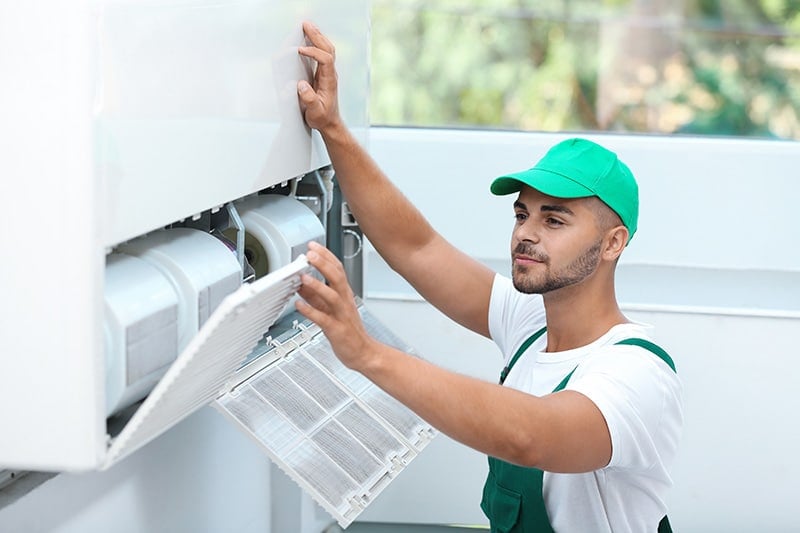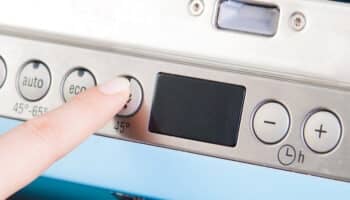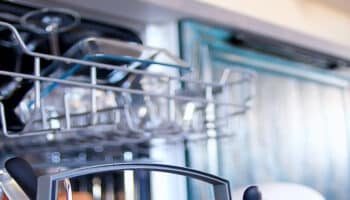Is your dishwasher overflowing with suds?
I’m sorry to hear that! I understand how annoying it can be to deal with a sudsy mess, especially when you’re in a hurry.
Luckily, you’ve come to the right place to fix the problem.
If your dishwasher has more suds than a laundromat, you’re probably using the wrong type or amount of detergent. However, if the issue persists, there’s likely an issue with the door seal, drainage system, float switch, or water inlet valve.
Read on to prevent your dishwasher from overflowing with suds!
Dishwasher Overflowing With Suds? 5 Reasons Why (With Fixes)
In this section, I’ll explain why your dishwasher overflows with suds and provide different tips to help you prevent the issue from happening again.
Keep in mind that if the first solution mentioned in this article doesn’t solve the problem, you’ll need to examine certain components. So, it’s essential to have the manufacturer’s manual handy for reference.
Can’t find your manual? Don’t worry! Click the link below to learn how to find any product’s manual online.
Are you ready? Let’s get started!
#1 Wrong Type and Amount of Detergent
I find that when a dishwasher overflows with suds, it’s typically because the wrong type and amount of detergent was used.
Dishwashers are designed to work with a specific type of detergent that doesn’t produce too many suds, ensuring the best cleaning results. Regular dish soap and standard detergents create lots of foamy suds, which is great for handwashing dishes since it helps break down grease; however, it’s not recommended for dishwashers.
If you use regular soap in your dishwasher, you’ll end up with a sudsy mess. Therefore, you should stick to detergents that are specifically designed to be used in dishwashers.
Choosing the right detergent is crucial, but so is getting the amount right. Using too much detergent can also lead to excessive suds, especially in areas with soft water.
To ensure you’re using the right amount of detergent, simply refer to your dishwasher’s manual or the product’s instructions. They typically include recommendations that help you ensure the best cleaning results and prevent issues like excessive suds or residue buildup.
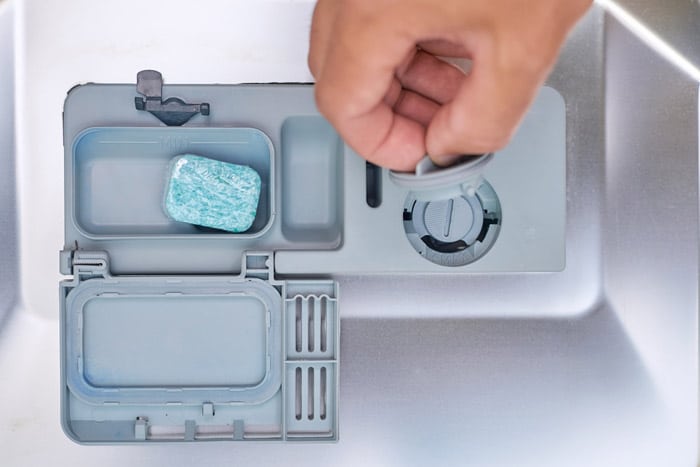
If you accidentally used dish soap in your dishwasher, don’t worry! Here’s how you can stop the mess before it damages your floors:
- Stop the cycle by pressing the “Cancel” or “Stop” button.
- Unplug your dishwasher from the power outlet or turn it off at the circuit breaker to prevent electrical hazards.
- Place a towel on the floor.
- Open the dishwasher and remove the dishes.
- Use a bowl to scoop out as much of the suds as possible.
- Sprinkle table salt directly onto the suds left in your dishwasher. Salt will start to break them down.
- Wait for a few minutes and run a rinse cycle.
- Clean the floor.
#2 Damaged Door Gasket
If you’re using the right type and amount of detergent, but your dishwasher is still overflowing with suds, you’ll need to examine the door gasket.
The door gasket forms a tight seal that prevents water from escaping while the dishwasher runs. Unfortunately, if the door seal is damaged or dirty, water and suds can leak out, making it seem like there are excess suds inside the dishwasher.
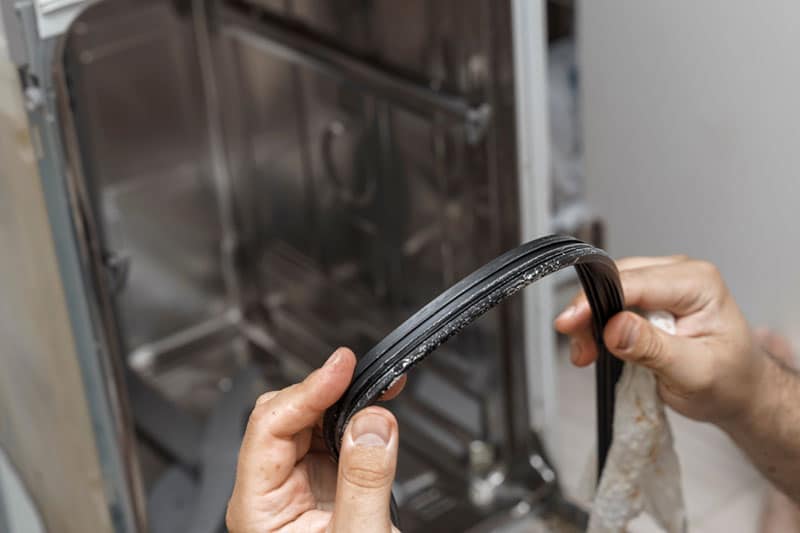
Therefore, cleaning the door seal and looking for any visible signs of damage is important. Here’s how to do it:
- Open the dishwasher door.
- Gently wipe down the door gasket with a soft cloth or an old toothbrush, using either soapy water or vinegar. Please pay special attention to stubborn debris or grease buildup, as they can interfere with the seal.
- Wipe the gasket again with a clean cloth to remove any product residue and let it dry to prevent mold growth.
- Once you’ve cleaned the gasket, look for any visible signs of damage, such as cracks, tears, or holes. If the gasket is broken or loose, you should get a replacement.
#3 Drainage Issues
When fixing a dishwasher with excessive suds, my usual advice is to inspect the drainage system.
The drainage system is responsible for removing the used water at the end of each cycle. Unfortunately, if there’s a drainage issue, old soapy water can mix with fresh detergent during the next cycle, causing excessive suds.
Follow these simple tips to fix your dishwasher’s drainage problems:
- Clean the filter that is located at the bottom of the dishwasher. I recommend using hot soapy water and a wire brush. Pay special attention to any stubborn debris. Don’t forget to clean the filter housing as well.
- Inspect the drain hose. The hose can restrict water flow if kinked, so please straighten it. It’s also important to make sure the hose is not clogged with debris. If necessary, use a long brush to clean it. However, if you notice any signs of damage, please purchase a replacement.
- Check the garbage disposal. If your dishwasher is connected to the garbage disposal, you’ll need to run the disposal to clear any blockages. It’s also important to confirm that you’ve removed the knockout plug in the disposal.
- Examine the drain pump. Sometimes, objects and food debris can block the drain pump and cause drainage issues, so please remove any obstructions. If the drain pump is malfunctioning, you must replace it with a new one.
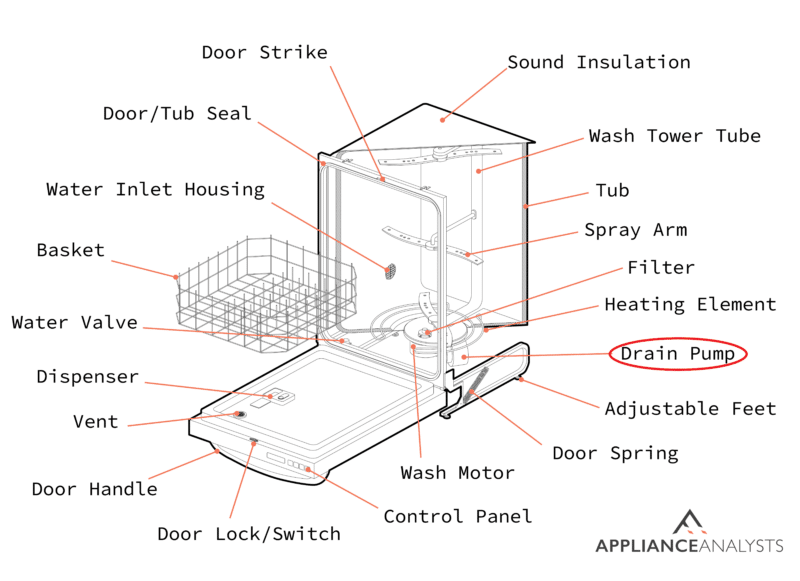
#4 Malfunctioning Float Assembly
A faulty float assembly can also explain why your dishwasher is overflowing with suds.
Let me explain. When your dishwasher fills with water, a floating device located at the bottom of the unit rises with the water level. Then, the float switch activates and stops the water flow to prevent leaks and other performance issues.
Unfortunately, if there’s a problem with the float assembly, the balance between water and detergents becomes disputed, leading to excessive suds.
To inspect the float switch, please access it and check if it moves freely up and down. If it’s stuck, try cleaning it with an old toothbrush or soft sponge.
However, if the float assembly is broken or damaged, you’ll need to get the necessary replacements. Please refer to the manufacturer’s manual for detailed instructions.
#5 Faulty Water Valve
If you’ve tried all the fixes mentioned in this article, but your dishwasher is still overflowing with suds, then it’s time to check the water valve, which is responsible for allowing water to enter the unit when the cycle starts.
Your dishwasher needs the right amount of detergent and water mixed to clean your dishes effectively. Unfortunately, if the water valve is faulty, it can let in more water than intended, leading to excessive suds and extra rinse cycles.
To determine if the water inlet valve is malfunctioning, please follow these simple instructions:
- Unplug your dishwasher from the power source or turn it off at the circuit breaker to prevent electrical hazards. Then, turn off the water supply.
- Access the water inlet valve, which is typically located behind the lower kick plate. If necessary, refer to the manufacturer’s manual for detailed instructions.
- Look for any visible signs of damage, such as cracks or wear.
- Test the water inlet valve with a multimeter. You should get a reading between 500 and 1500 ohms of resistance (or the one recommended by the manufacturer). If the digital display doesn’t change significantly, you’ll need to replace the water valve.
Note: You can also check if the water valve is stuck in the open position by opening the dishwasher door during the fill cycle. If the unit continues to fill even after you’ve opened the door, it’s a sign that the water inlet valve is faulty and needs replacement.
Keep in mind that if you’re uncomfortable testing or replacing your dishwasher’s components, it’s best to call a professional. They have the required tools and expertise to diagnose and fix the issue.
Wrapping Up: Troubleshooting Your Dishwasher’s Suds
That about covers it! Hopefully, now you know how to prevent your dishwasher from overflowing with suds.
Remember that if your dishwasher has more suds than a laundromat, you’ll need to make sure you’re using the right type and amount of detergent, as regular dish soap can cause excessive suds.
However, if the detergent isn’t the issue, don’t forget to inspect the door seal, float assembly, drainage system, and water inlet valve. Replace any components as needed.
Thank you so much for taking the time to read this guide. If you ever experience a different issue while using your dishwasher, please check out our site.
Have a great day!



